Owning, maintaining, and providing active use within a single family settlement era house is not a typical mission for a public parks agency. One such property is the Reynold & Eva Briggs House located in the northeast corner of the Dorris Ranch Living History Farm, in Springfield, Oregon, currently stewarded by Willamalane Parks and Recreation District (WPRD). Compounding the unusual situation is that the area is a historic site, a working farm, and a public park. In addition the property’s history, age, material, and conditions of the house add further complexity to the stewardship role. In order to guide the WPRD with long-range decisions regarding the Briggs House, the District sought an up to date exterior and interior condition assessment and potential rehabilitation options in support of current and future park programming needs, including as a source of income derived from continued residential use. The Briggs House has not been occupied since its last resident left in 2009.
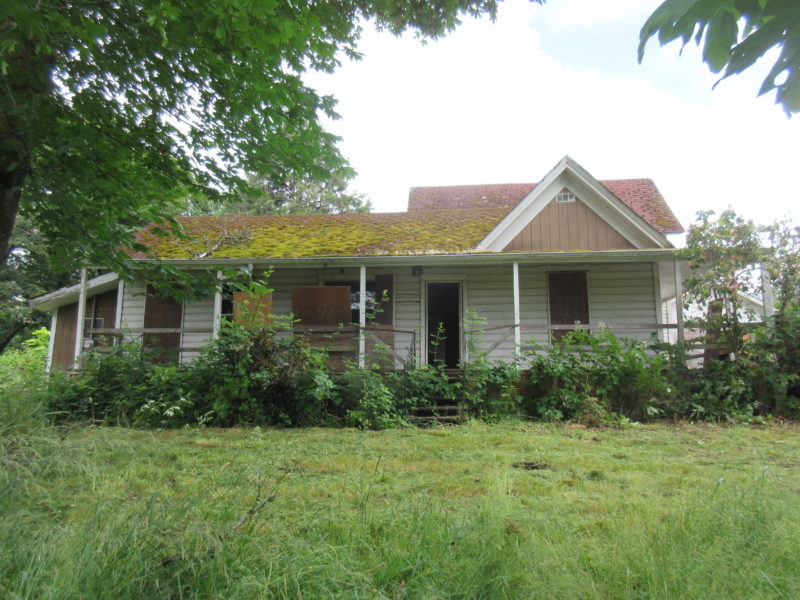
THE ASSESSMENT
The property, The Dorris Ranch Living History Farm, was listed as a National Register of Historic Places Historic District on June 22, 1988. While the Briggs House is located on the ranch property, it sits outside the boundaries of the historic district.
As researched by University of Oregon historic preservation students, the settlement era house is one of the five oldest houses in the Springfield area and one of the city’s few remaining examples of box construction from the Homestead era. The oldest portion of the house—the two-story volume and its eastern wing—was originally constructed by George Thurston in 1872, and later served as the home of caretakers Reynold and Eva Briggs. Once vernacular in the Willamette Valley, the house exhibits a Gothic-influenced upright-and-wing style of construction and was expanded in the 1890’s to accommodate the changing needs of its residents.
Typical of early homestead sites, the Briggs House was constructed without a foundation. The original substructure that continues to support the house consists of partially hewn wood posts on stone piers set directly on the ground surface. Utilizing the box-construction method, 1-inch by 11-inch boards were set vertically and connected to the 7-inch by 9-inch sill plate and ledger plate above the posts to create a “box” form without the use of other framing members. Two-inch by 4-inch roof rafters were then set above the top ledger plates. Floor joists, the original board-and-battens wall siding, and roof panels were added to the house after its basic skeletal structure had been completed. The original wall siding was replaced with weatherboards at an unknown date. Portions of this siding were later replaced with shiplap in the 1890’s, and the entire exterior was later covered with T-111 siding in the 1970’s.
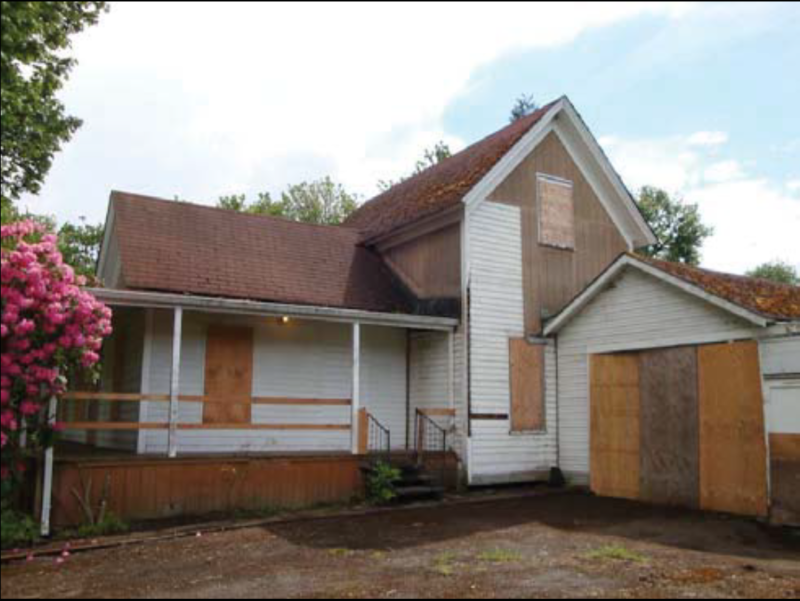
REHABILITATION CHALLENGES
After discussing the main program activities that take place on Dorris Ranch with Willamalane Parks and Recreation District staff, PMA recognized the primary challenge to any rehabilitation options was the balance between maintaining the historic character of the house and meeting all the code requirements mandated by a rehabilitation, including public access, universal access, and mechanical, electrical, energy, and plumbing upgrades. Previous studies undertaken by Restore Oregon on similar settlement era houses indicated that a balance must be reached between preserving the essence of the house while changing and modifying other portions of the house and property to achieve programming needs. Complicating the Briggs House options are siting of the house within an active area of the park, the two story volume, the lack of an adequate structural foundation, and accommodating large classroom needs within original tiny floor plans. Every room of the historic property has an established spatial function and are tiny in size. Any rehabilitation option must consider that all rooms in the house would be “flexible” and be used as needed for a variety of purposes.
THE POTENTIAL ROLE OF HISTORIC STATUS
Willamalane Parks and Recreation District currently stewards the Briggs House as a historic property by maintaining and protecting the property from encroachment by nature, animal and pest infestation, and unsafe use by park visitors. Inclusion of the property within the district as a contributing resource has both pro and con impacts. Inclusion within an expanded boundary of the current National Register Dorris Ranch Historic District could prove beneficial in finding financial sources to help with a rehabilitation although the available funds are likely insignificant when evaluated against the full cost required to upgrade the Briggs house to a public structure. On the other hand, including the property in the district may prove problematic for WPRD as it may limit, or make more difficult, viable and creative rehabilitation options that would not be approved by the local jurisdiction having authority.
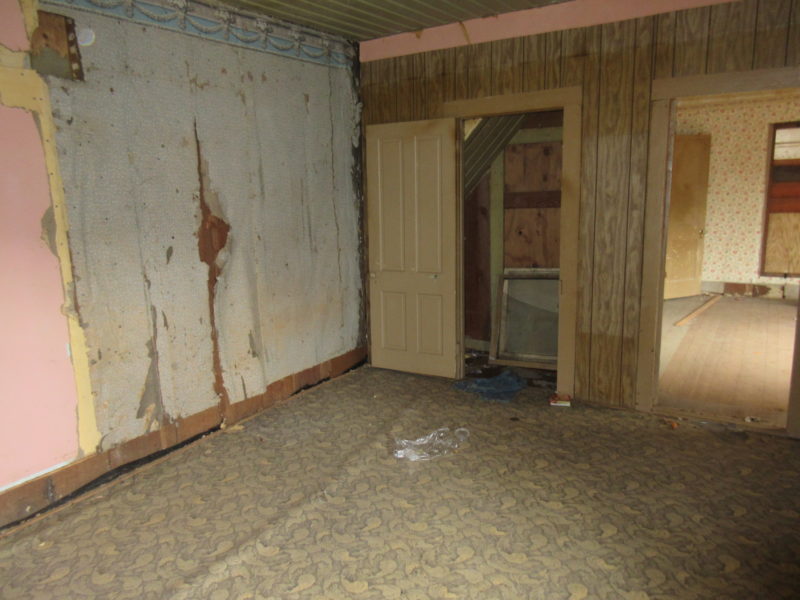
It is generally agreed that house museums (properties that are preserved as homes to be visited by the public) are not financially prudent uses to retain historic properties. Recent studies conclude that a compromise must occur between balancing original historic character with up to date and flexible programming space to achieve viable long-term solutions for unique homestead-era properties.
Written By Marion Rosas / Designer and Peter Meijer, AIA, NCARB / Principal
Tag Archives: architecture
Integrating Universal Access with Historic Architecture
Oregon State University (OSU) is dedicated to providing universal accessibility throughout its Corvallis campus. The historic Memorial Union building opened in 1927, and is an important gathering place on campus. In its current configuration, the rotunda entry access poses challenges to complying with current ADA Standards for Accessible Design. PMA with our multidisciplinary team members are addressing how to improve the arrival experience starting from the Quad by focusing on the front door as the primary accessible entry, while retaining the buildings historic integrity. With an integrated approach there will be a primary travel path for all.
The existing limitations of accessibility to the MU are the existing ramps do not lead to the front entrance and the circulation through the rotunda requires use of non-compliant ramps. The existing exterior 1980s ramps were built interior of the terrace’s balustrade wall and access is not intuitive and requires signage. They take up significant portion of the historic terrace with circulation and railings.
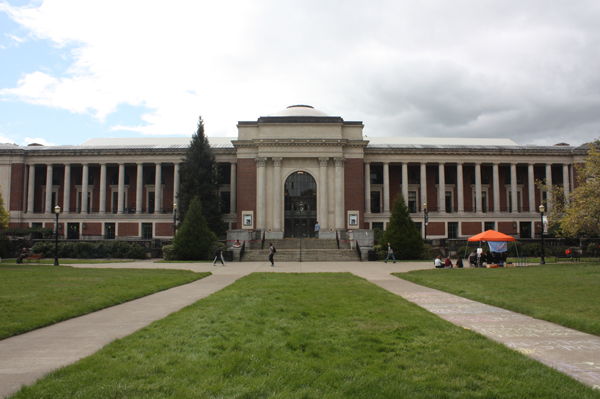
OPPORTUNITY FOR INTEGRATING UNIVERSAL ACCESS
The renovation of OSU MU Rotunda provides an opportunity to highlight the integration of universal access to historic properties. The vision for a new accessible path is integrated into the highly ordered Neo-classical design of the MU creating a symmetrical entry on either side of the grand entry stairs facing the quad. The design seeks to reactivate the formal side terraces by eliminating the clutter of handrails and circulation space that currently breaks up the space.
The new accessible pathway will be a sloped walkway along the exterior of the existing balustrade wall of the terraces. A 4.5 % sloped walkway will be integrated into the landscape and will free the space of guardrails. This will result in greater visibility of the accessible means of access to the building and restore the original spatial function of the terraces. Another slope walkway will lead from the terrace to the front entrance and will be integrated into a tiered landscape and informal setting area. The new design will reactive the terraces by streamlining circulation and providing new seating opportunities.
PROPOSED DESIGN OPTIONS
Two design options were explored for this scheme. The first design option removes a portion of the balustrade wall closest to the grand entry. This would open up views of the entry and terrace to the quad and provide additional visibility of the accessible pathway. The second option would leave the balustrade wall in place and would create more of an intimate feel along the terrace. Below are renderings of the first design option.
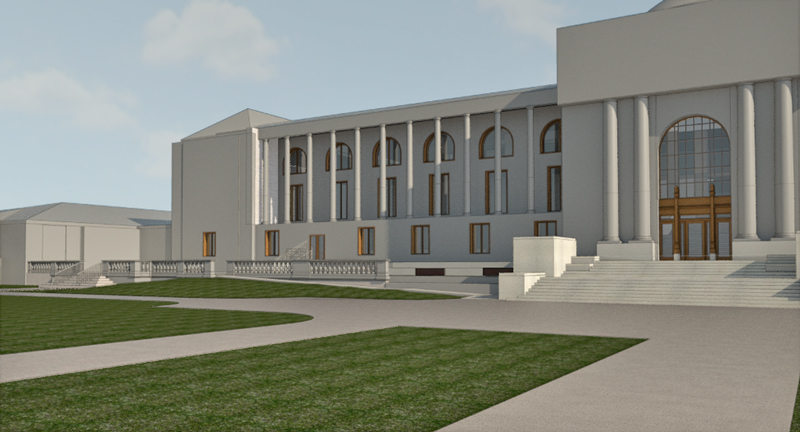
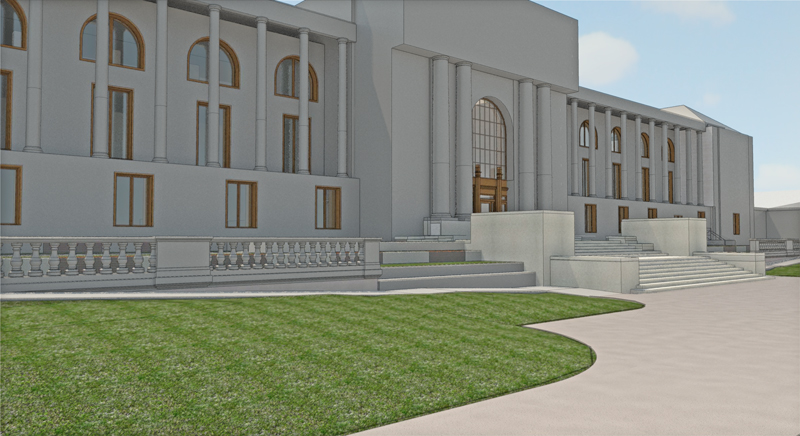
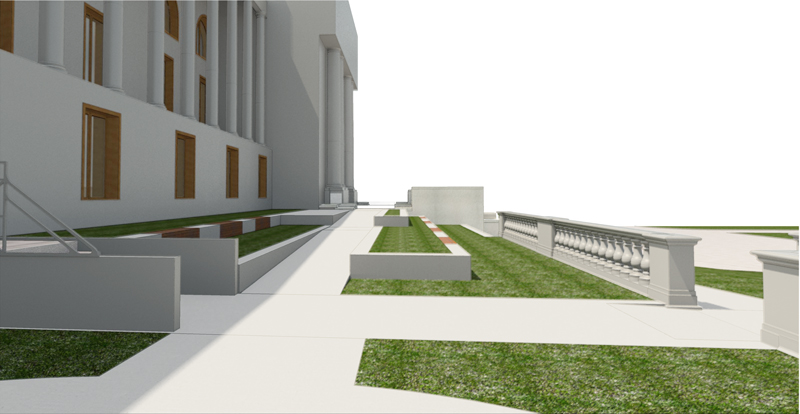
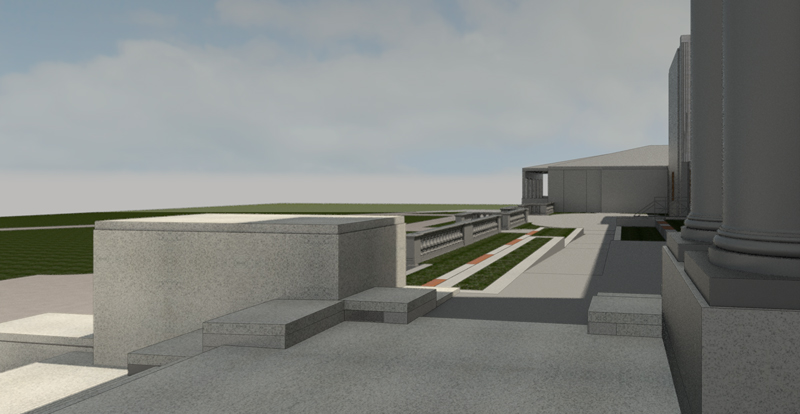
Written by Hali Knight / Designer.
Preservation Month 2017
May is Preservation Month! Review ten (10) handy preservation resources:
ONE – We explore some factors and opinions on new construction in Historic Districts.
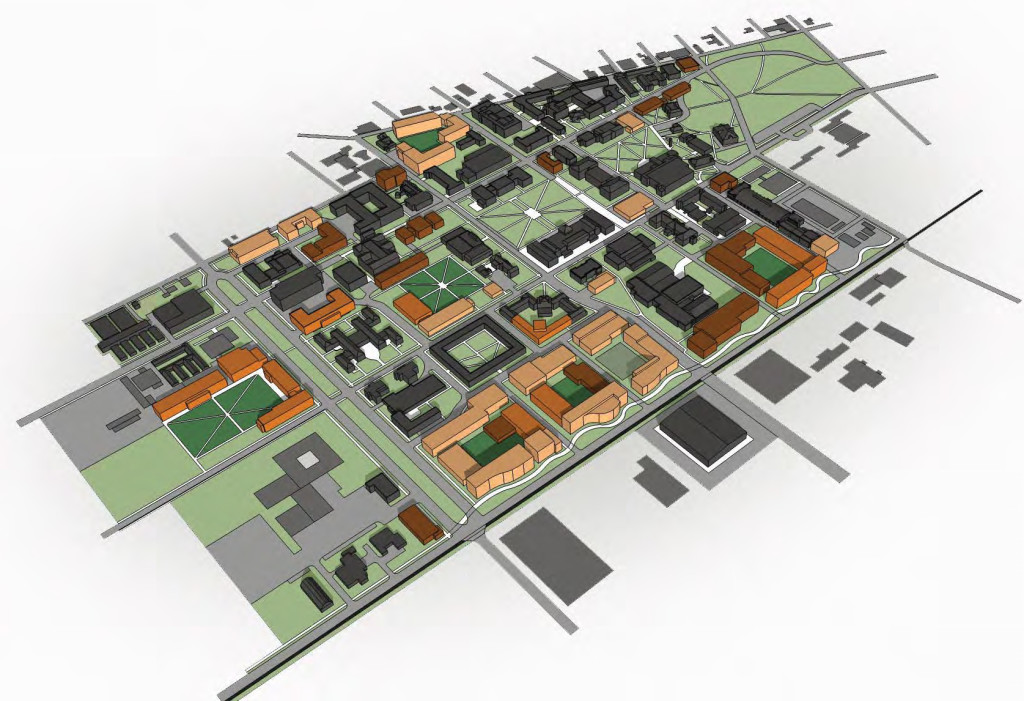
TWO – An iconic example of a landmarked building less than 50 years old.
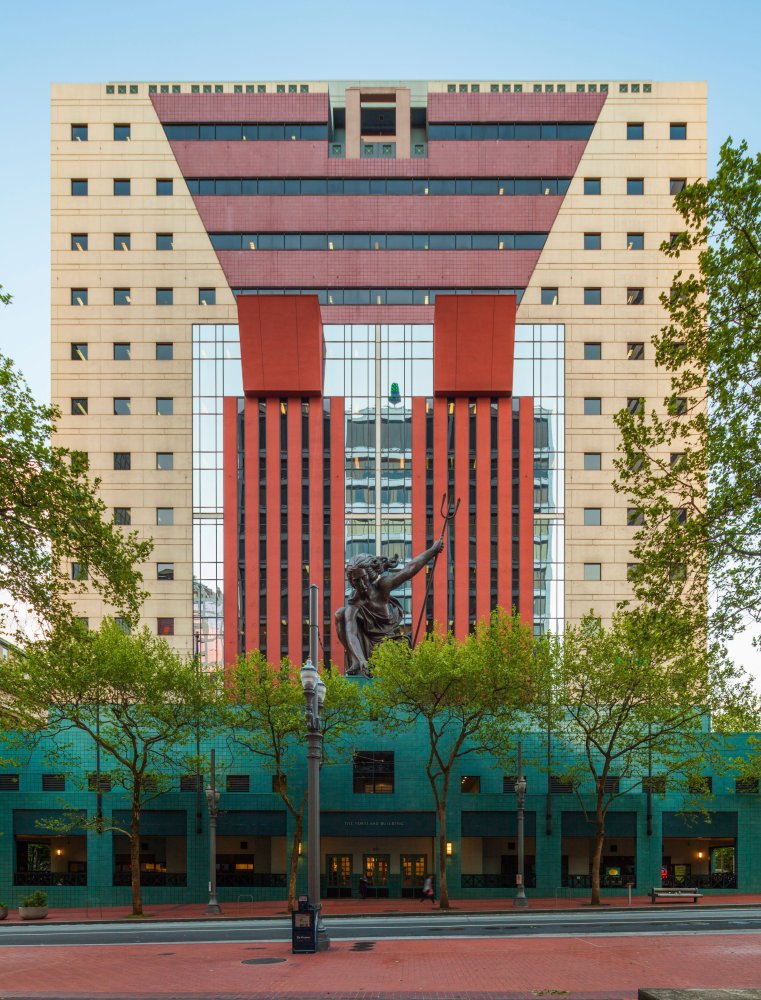
THREE – Visit Oregon’s SHPO website to browse historic sites, NR listings, & available grants.
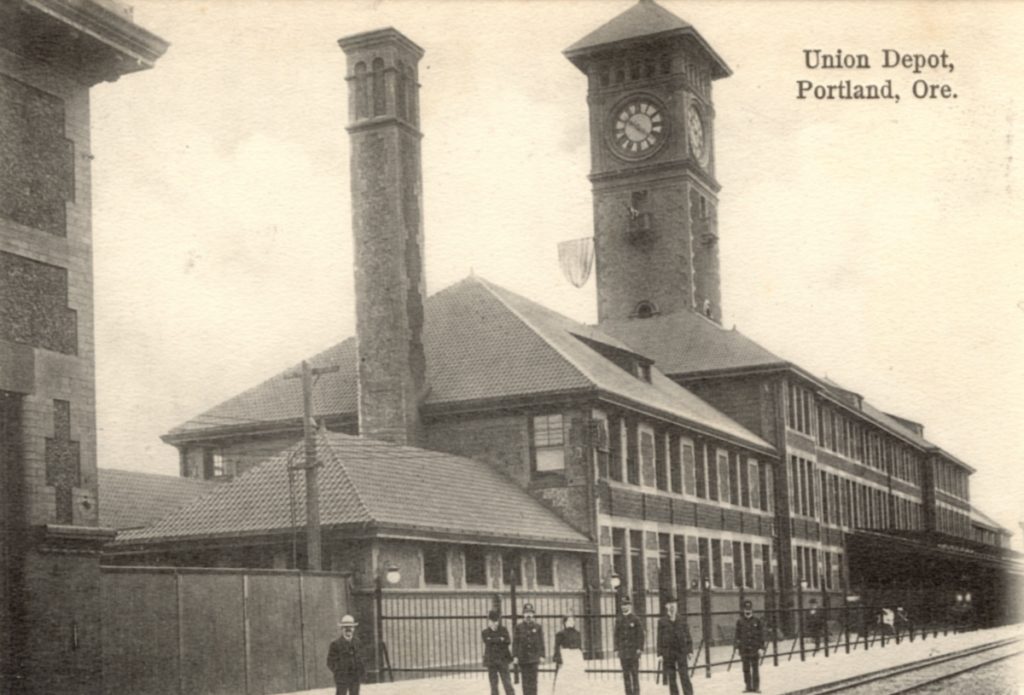
FOUR – Get to know your local architectural styles from the 1840s – 1970s.
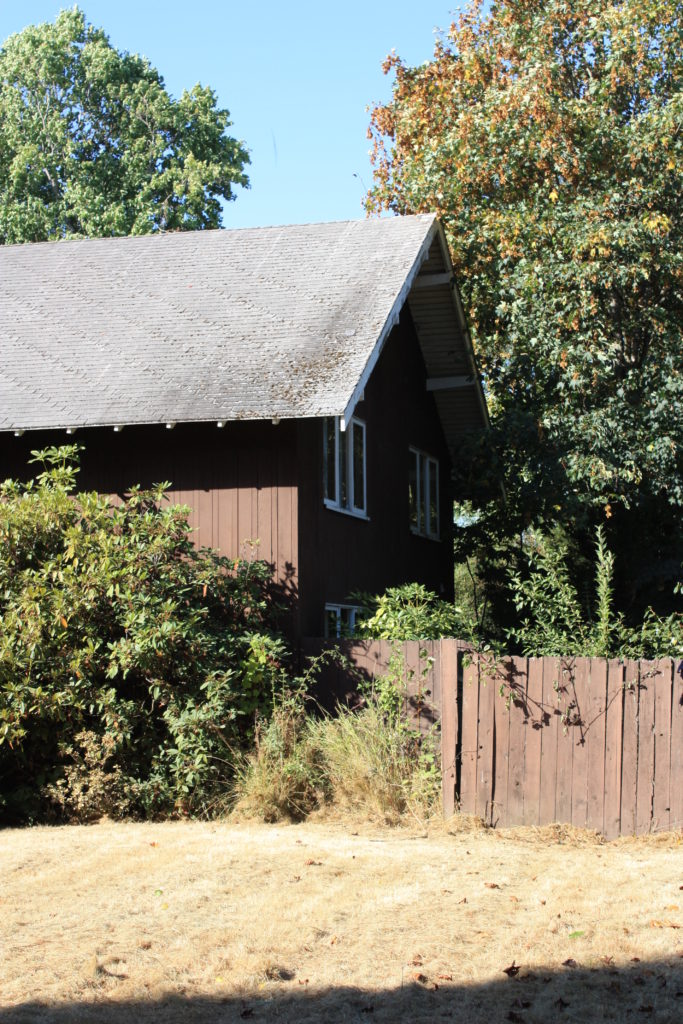
FIVE – Pledge your support for a rehabilitated VMC because this place matters.
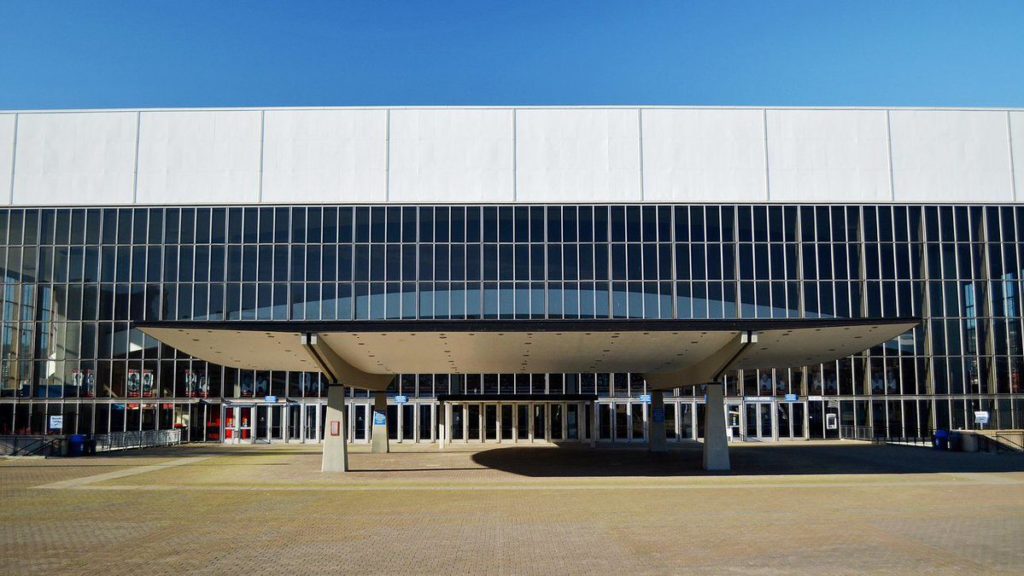
SIX – How you can find a historic place in the state of Washington.
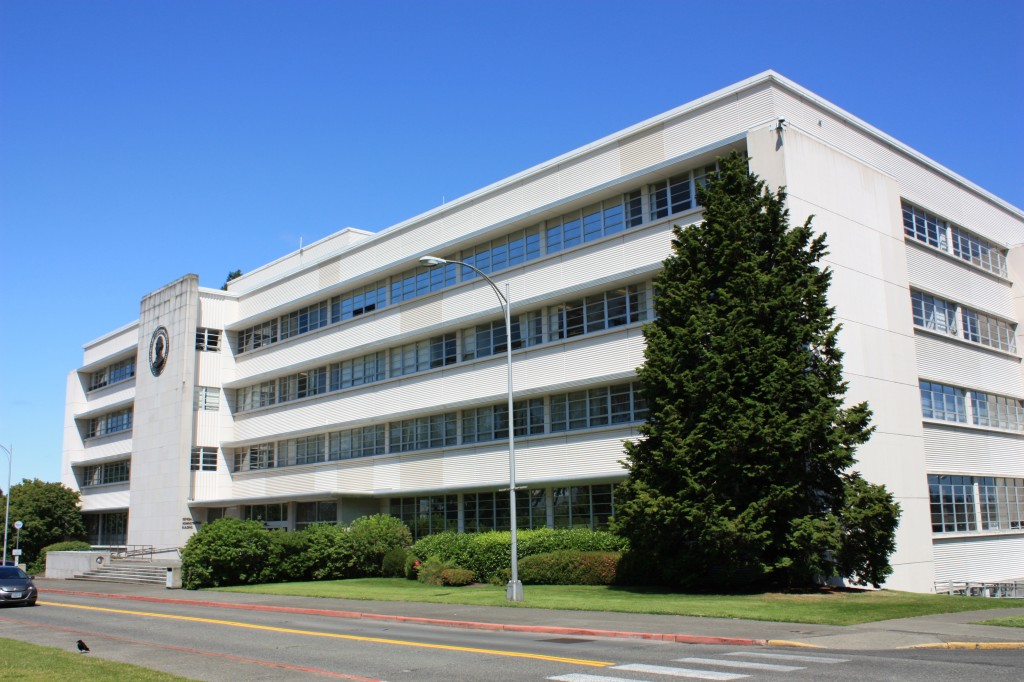
SEVEN – Tax Incentives for Preserving Historic Properties.
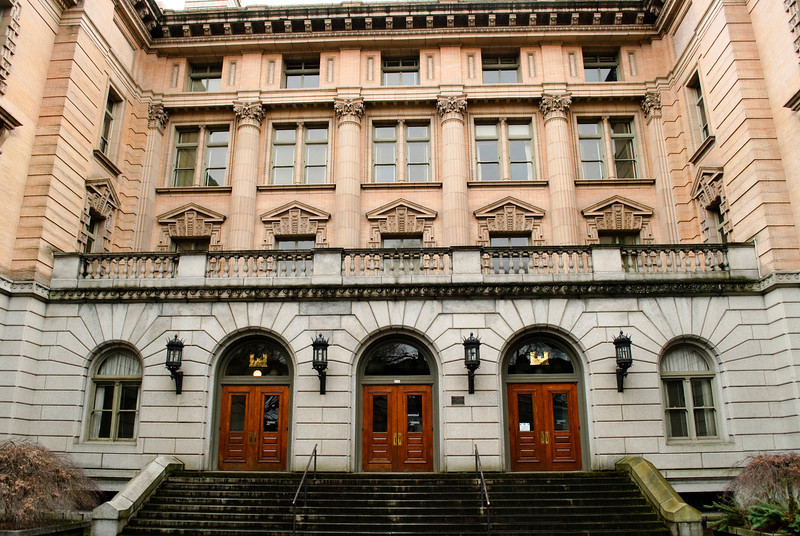
EIGHT – Oregon’s Most Endangered Places via Restore Oregon.
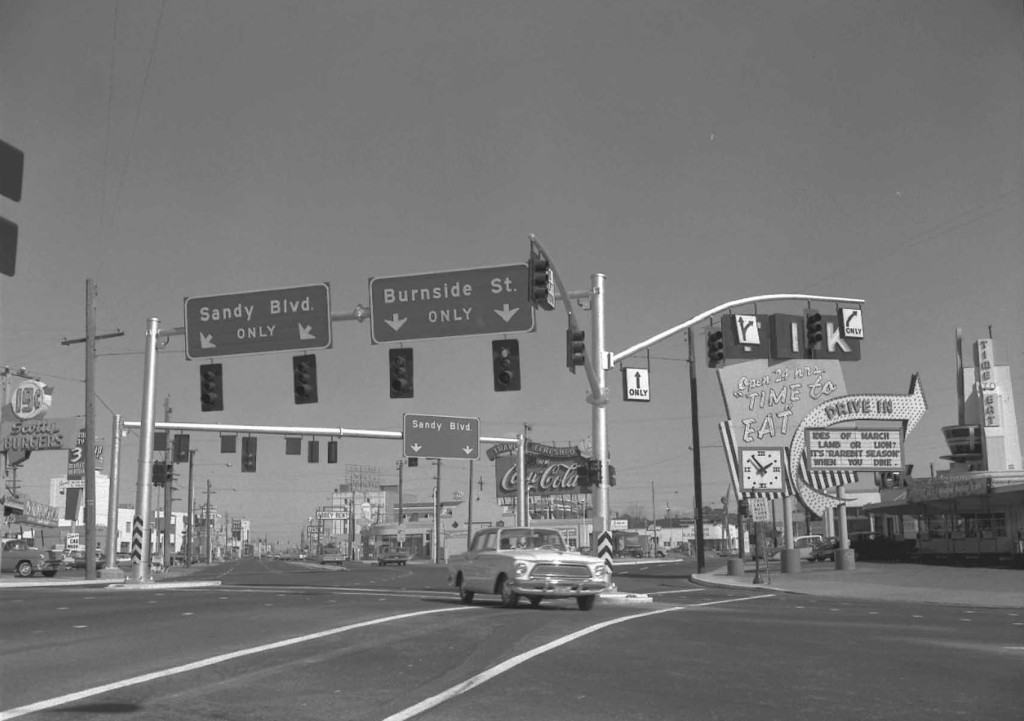
NINE – Keeping It Modern. An architectural conservation grants for 20th century buildings.
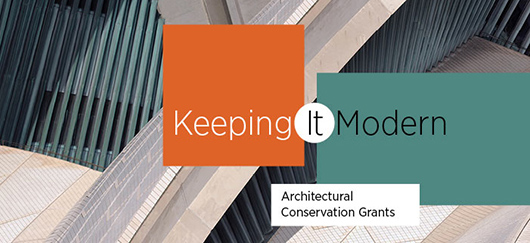
TEN – How Historic Preservation is Reviving America’s Communities.
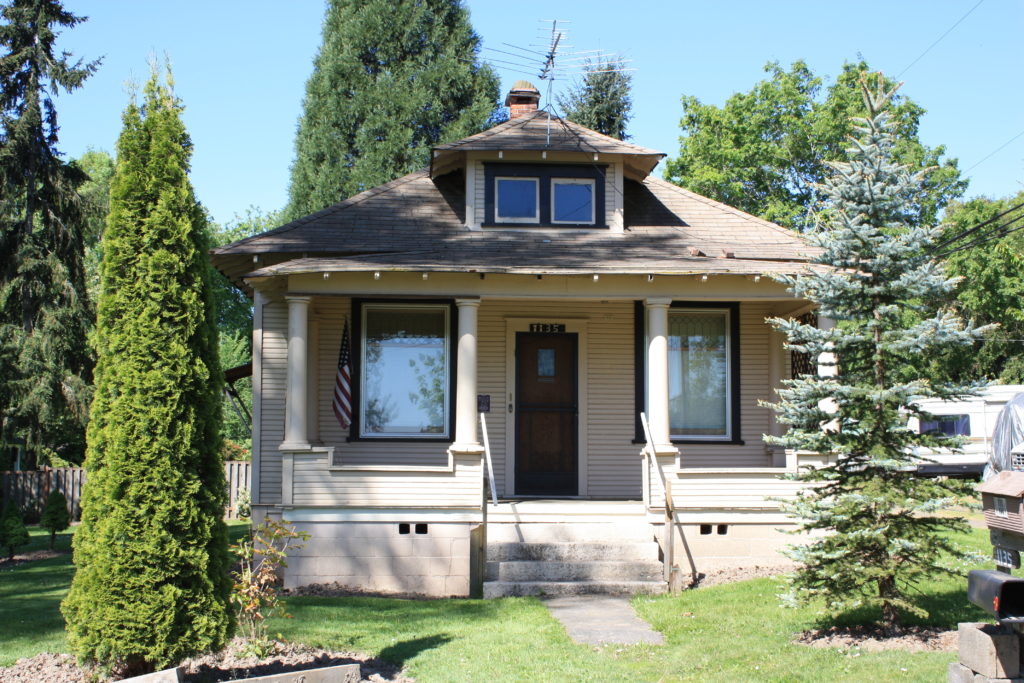
Long Term Impacts of Masonry Waterproofing Sealers
Product X works as a masonry sealer, but what are the long-term ramifications of using Product X on masonry buildings? Masonry sealers come in a wide variety of formulations, but how do the various chemical compositions react to environmental conditions and what affect does the formulation have on the masonry? Most masonry waterproofing sealers specified by architects and conservators, installed by contractors, and requested by property owners are based on Silicone (═Si═ ) chemistry. There are three popular groups of silicone based materials being used as waterproofing materials: 1) silicates, 2) the group of silane, siloxane, siliconate; and 3) silicones. Silicates, similar to Product X, provide waterproofing properties by filling the pore structure of building materials with silicon dioxide (SiO2) precipitation. Common silicates are sand, Portland cement, and other natural occurring minerals. Silanes, siloxanes and siliconates provide waterproofing properties by bonding with the substrate. They are often referred to as penetrating sealers. Silicones do not form chemical bonds with the substrate. Silicones provide waterproofing properties by forming a non-bonded film. Such products are labeled as thin-film sealers.
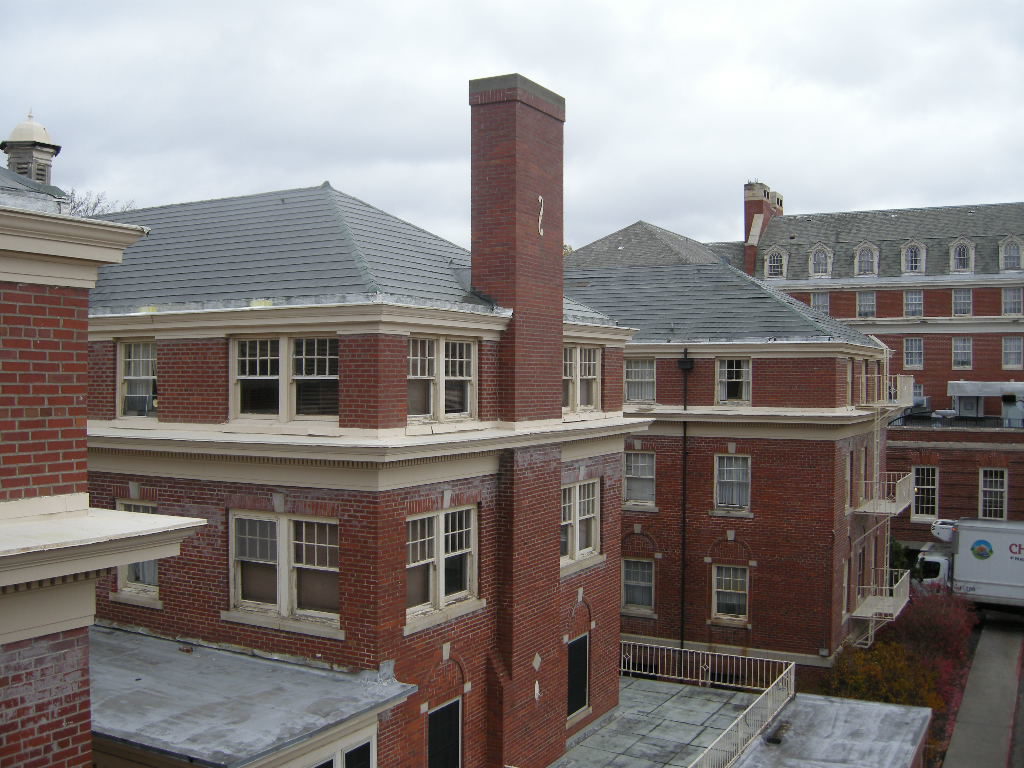
SILICATES
Silicates are most commonly used in crystalline type water proofing agents for concrete. Their use is generally focused on concrete substrates. However, it is known that strongly alkaline, aqueous solutions of methyl silicates can be used to impregnate masonry. Such solutions often depend upon caustic soda for their alkalinity. Impregnation of masonry with such solutions is often disadvantageous, however, particularly due to the high alkalinity. For example, the high caustic soda content of the solution will cause a gradual removal of the organosilicon compounds from the interstices of the masonry by chemical combination with the surfaces of the masonry surrounding the interstitial voids. Moreover, the caustic soda solution reacts with carbon dioxide or other acidic components of the air which gives rise to salting out and the formation of efflorescence on the masonry. (1)
SILANE, SILOXANE, SILCONATES
Silane, siloxane, silconates are penetrating type of sealants. Their effectiveness is dependend on the porosity of the substrate and the dosage of repellant applied. Each manufacturer will have unique requirements for the application and dwell time of their sealer. Silanes and siloxanes form a chemical bond with siliceous containing materials. Silanes and siloxanes go through three reactions when applied to a masonry surface: hydroloysis, condensation, and bonding. During the condensation phase, the moisture vapor transmission rate is critical to preventing moisture accumulation behind the sealer layer.
With penetration type sealers, it is critical to the longevity of substrate (masonry) that the moisture vapor transmission of the sealer is actually known. There has been very little third party testing of vapor transmission and each product manufacturer provides varying ways of testing transmission. In addition, the active ingredient content of the sealer formulation and the coverage rate will greatly affect the moisture vapor transmission. In other words, performance in the field will vary greatly from highly controlled laboratory testing.
Siliconates are water soluble and they impart water repellency on porous surfaces. A drawback to using diluted siliconate solution for waterproofing applications is that siliconates react with carbon dioxide and carbonatious matters present in the substrate to form a water repellent, water-insoluble, white colored precipitate. This white layer may become quite visible and require aggressive removal procedures resulting in objectionable appearance or scarification of the surface during removal processes.
SILICONE
The effectiveness of silicone sealer depends on the alkyl group used (which directly influences its resistance to alkaline conditions), the amount of exposure to ultraviolet light and the level of moisture in the masonry when the silicone is applied. (2)
The proliferation of masonry coatings on the market, and the continued pervasive use of the coatings, requires the architect, engineer, contractor, and conservator become more knowledgeable on the wide variety of coating formulations, the continued evolution of those formulations, and understand both the right application of the product and potential detrimental effects of using the wrong product on historic substrates.
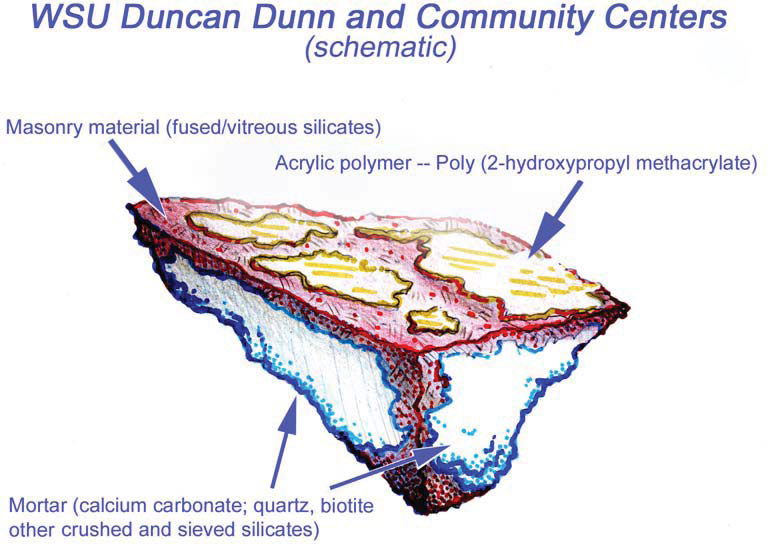
CASE STUDY: WASHINGTON STATE UNIVERSITY, DUNCAN DUNN HALL
In preparation of a major renovation, Peter Meijer Architect, PC was retained in 2010 to conduct a general exterior condition assessment of Duncan Dunn Hall on the campus of Washington State University, Pullman, Washington.
Duncan Dunn was constructed in 1926 as a women’s dormitory for Washington State University, then named Washington State College. It is located in the heart of the WSU campus, facing north towards Linden Avenue. First known as the “New Dorm,” the building cost $150,000.00 to build at that time, and could house 140 students. The architect, Stanley Smith, was the head of the department of architectural engineering and was also the official University Architect.
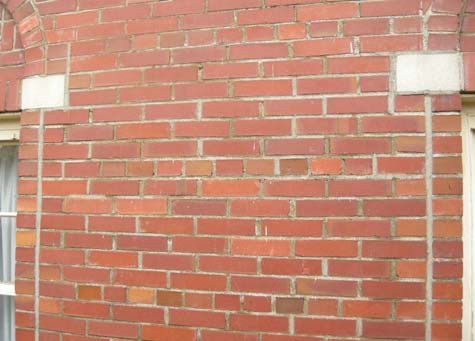
The predominant material present on Duncan Dunn is a solid brick unit, brownish red in color, and approximately 8” x 3 7/8” x 2 3/8” in size. At the time of assessment the brick had a very prominent unsightly, white coating over 60% of the masonry facades.
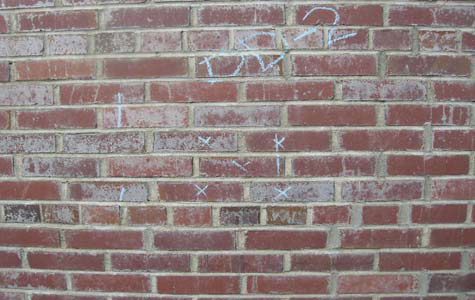 Believing the white haze was a result of UV degradation of a masonry sealer, PMA conducted Reunion Internationale des Laboratoires D’essais et de Recherches sur les Materiaux et les Constructions (RILEM) tube tests of water absorption on the exterior brick on Duncan Dunn Hall. The area of brick chosen for the test was out of direct sunlight to avoid affecting the results and was conducted during dry weather. No movement of the water over a 45 minute period was recorded during the test. Masonry units, even those constructed with high quality clays under controlled firing conditions will absorb some water. The results of the field test on Duncan Dunn, along with the white surface haze, reinforced the assumption of the presence of a masonry coating.
Believing the white haze was a result of UV degradation of a masonry sealer, PMA conducted Reunion Internationale des Laboratoires D’essais et de Recherches sur les Materiaux et les Constructions (RILEM) tube tests of water absorption on the exterior brick on Duncan Dunn Hall. The area of brick chosen for the test was out of direct sunlight to avoid affecting the results and was conducted during dry weather. No movement of the water over a 45 minute period was recorded during the test. Masonry units, even those constructed with high quality clays under controlled firing conditions will absorb some water. The results of the field test on Duncan Dunn, along with the white surface haze, reinforced the assumption of the presence of a masonry coating.
Communication with WSU personnel and their internal research surmised that “the building may have had a sealer put on after the original construction. [WSU cannot verify the application through original records] but do know [that a sealer] was not used on a regular basis after [construction completion.] Back in the 70’s some “miracle sealer” of some sort was introduced on Campus and used at a few locations. Duncan Dunn Hall was among the buildings [receiving masonry sealers.] Today you can see the remnants of this as a white powdery surface that almost looks like efflorescence. [WSU] does not know the name of [the sealer] product.”
To confirm the presence of the sealer, PMA conducted lab testing via polarized light microscopy (PLM) episcopic microscopy, capillary fusion and Fourier-transform infrared spectroscopy (FTIR) per ASTM D1245 and E1252, respectively. FTIR indicated the material to be Poly(2-hydroxypropyl methacrylate), an initially water-miscible acrylic polymer that in these samples is at present very brittle and sloughs rather easily.Testing confirmed the presence of a “water-miscible acrylic polymer”. Due to chemical breakdown under UV, the chalky coating remaining on Duncan Dunn is no longer soluble in water.Because of the insoluble nature of the white haze, low pressure hot-water cleaning methods would not be successful. PMA recommended the Rotec Vortex cleaning system using a mirco-abrasive mixture of dolomite, water, and air. Ultimately this removal processes was successful with no damage to the masonry surface.
(1) Patent application for new formulation of sealers. (2) Types of Masonry Water Repellents, GSA web site. Information derived from ProSoCo Inc. product literature.
Written by Peter Meijer AIA, NCARB / Principal
Analyzing Historic Masonry Wall Performance
Wilmer-Davis Hall is a residential complex on the Washington State University (WSU) Pullman campus. Built in 1937 by Architect Stanly Smith, with John Maloney, the six-story structure is composed of masonry and concrete with a masonry/brick veneer in the classical and Georgian Revival architectural styles. For a recent feasibility study of the complex, PMA provided an exterior assessment and a limited moisture study utilizing Wärme Und Feuchte Instationär (WUFI), an industry standard application in predicting wall performance to determine how additional insulation may impact the existing constructions and wall performance.
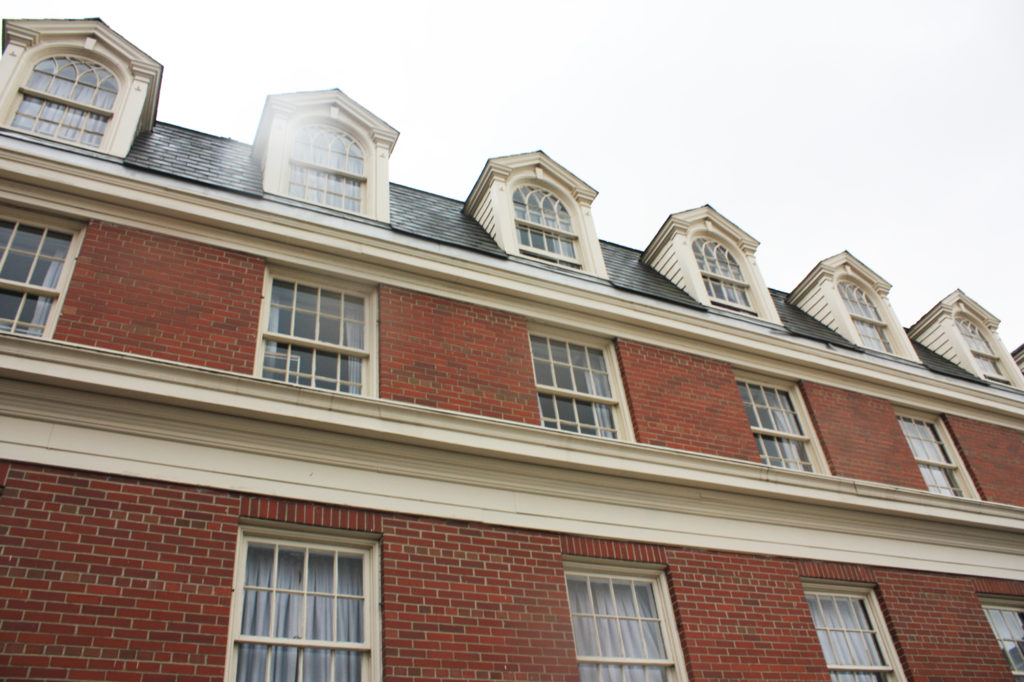
The primary concerns of this analysis included increased potential for freeze thaw action and increased mold growth as a result of added insulation. When historic buildings are insulated the insulation is typically added to the interior of the structure to prevent alterations to the exterior appearance. This often causes the outer layers of the wall to be both colder and wetter as the materials are no longer warmed and dried by the interior heating system. The additional water and more extreme temperatures can result in an increase in freeze thaw action, corrosion of metal reinforcement, and/or increased mold growth.
Additionally adding insulation to a wall changes the location of the dew point within that construction (the point at which vapor in the air condenses into water). A dew point within the middle of the wall can also result in increased moisture within the wall cavity. If a wall has difficulties drying due to any of the above causes it is possible that over the course of several years the quantity of water within the wall will consistently increase. Accumulation of water will exacerbate reinforcement corrosion and mold growth and can result in increased freeze thaw action. This study focused on the following metrics to analyze proposed wall performance: quantity of water in the assembly, quantity of water in each material layer, relative humidity in layers susceptible to mold growth, and isopleths.
MODEL SETUP
As in any simulation analysis a number of assumptions were made regarding the existing wall construction and the proposed design conditions. A variety of different conditions were analyzed in order to explore the range of conditions and variables. Below is a description of the inputs as well as an analysis of the results.
Four (4) proposed wall constructions were analyzed to determine how different types, quantities, and configurations of insulation would impact the existing constructions. The configurations were based on outlined solutions for meeting Washington State Energy Code (WSEC) or providing improved thermal comfort. Two of the proposed constructions meet WSEC (Option 1 and Option 2), while two of the solutions (Option A and Option B) fall short of fully meeting WSEC, but would provide improved insulation values. The options simulated included:
Base Case (Existing Conditions) (R-4.8)
3-1/2” Masonry
1” Air Gap
7-1/2” Hollow Clay Tile Back-Up Wall
1-1/2” Plaster
Option 1 (Meets WSEC) (R-15.4, continuous insulation)
3-1/2” Masonry
1” Air Gap
7-1/2” Hollow Clay Tile Back-Up Wall
1-1/2” Plaster
2” Expanded Polystyrene
Vapor Retarder (1perm)
0” Gypsum
Option 2 (Meets WSEC) (R-20.9, insulation is not continuous)
3-1/2” Masonry
1” Air Gap
7-1/2” Hollow Clay Tile Back-Up Wall
1-1/2” Plaster
3” Batt Insulation
0-1/2” Expanded Polystyrene
Vapor Retarder (1perm)
0-5/8” Gypsum
Option A (R 17.4, insulation is not continuous)
3-1/2” Masonry
1” Air Gap
7-1/2” Hollow Clay Tile Back-Up Wall
1-1/2 Plaster
2” Foamed-In-Place Polyurethane
Vapor Retarder (1perm)
0-5/8” Gypsum
Option B (R-18.4, insulation is not continuous)
3-1/2” Masonry
1” Air Gap
7-1/2” Hollow Clay Tile Back-Up Wall
1-1/2” Plaster
3-1/2” Batt Insulation
Vapor Retarder (1perm)
0-5/8” Gypsum
MATERIALSIt should be noted that no material testing was performed during this phase of the project – instead default material properties were chosen from the WUFI database. Materials used include:
Weather/Interior Conditions In each simulation the model was set to mimic extreme situations to verify that the existing walls will perform in all conditions. The Spokane, Washington weather file indicates that the south elevation should have the most wind driven rain and moisture impacting the wall. Given this information the analysis used south exposure and the Spokane weather file to simulate exterior conditions. For the interior climate conditions the following profiles were used:
The above values represent a relatively high moisture load which is consistent with the existing use as a residential facility.
Water Intrusion Additionally as per ASHRAE 160 a small leak (1% of driving rain) was introduced into the exterior assembly to simulation a scenario where water was penetrating the exterior surface. This could occur at bondline failures in the mortar or penetrations through the wall assembly. The leak was placed past the masonry veneer on the face of the hollow clay tile backup wall.
Initial Conditions Lastly the initial conditions of the materials were determined using ASHRAE 160. For existing wall materials EMC80 was used as the initial moisture content. (EMC80 is a value expressing an equilibrium of water and material masses at 80% humidity). For new components the expectation was that the materials would be installed from the interior and would remain dry during the construction process – thus EMC80 was used for new components as well.
WUFI RESULTS
Four metrics were used to interpret and analyze the following WUFI results: Total Water Content/Water Content in Material Layers, Temperature, Relative Humidity, and Isopleths.
 Total Water Content WUFI can predict the total accumulation of water over the time frame of the simulation, in this case five years. Over the course of each year a wall assembly will be wetted by the rain, and dry over the summer months. Differences in humidity and temperature between spaces may cause water condensation within the walls. If conditions do not allow condensation or other water to dry, materials may accumulate water over a period of time.
Total Water Content WUFI can predict the total accumulation of water over the time frame of the simulation, in this case five years. Over the course of each year a wall assembly will be wetted by the rain, and dry over the summer months. Differences in humidity and temperature between spaces may cause water condensation within the walls. If conditions do not allow condensation or other water to dry, materials may accumulate water over a period of time.
The chart above shows how each of the different simulations performed. Note that total water content is measured per ft2 of wall. Walls that are thinner (existing construction) will inherently have less capacity to hold water. In general all of the walls performed in a similar manner – an indication that the retrofit strategies should perform in a comparable manner when compared to the existing walls. As can be seen in the chart, all of the simulations, including the base case showed some accumulation of water over the five year simulation. These results, however, do not conclusively show that the proposed walls will accumulate water. The results indicate that even the base case is accumulating water over time. During PMA’s site visit, however, the existing exterior walls appeared to be performing well – which would not be the case if they were consistently accumulating water. Additional analysis showed that the gradual accumulation of Total Water Content appears to be a result of initial instability within the wall construction that equalizes over time. A 20 year simulation showed accumulation over the first five years, after which the water content stabilizes.
Water Content in Material Layers Each of the individual layers of material in a wall assembly have the capacity to hold and retain water. A high water content in any individual layer can indicate the potential for mold growth, the possibility for damage associated with freeze thaw, and a reduction in R-Value based on moisture content. Mold growth is possible when the moisture content is above 20% and if the material has the capacity to feed mold growth. The charts below show how each simulation performed for each layer within the wall.
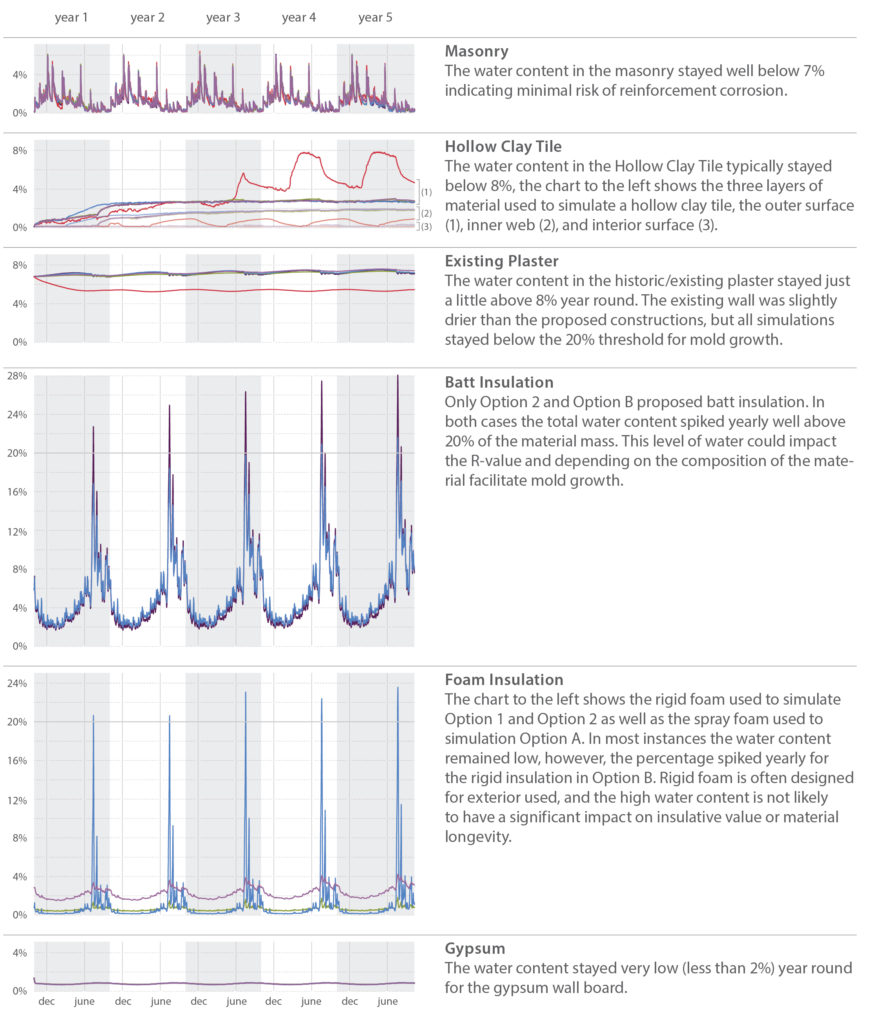 In general most layers remained well below the 20% threshold for mold growth. The insulation layers, however, are an exception. Options 2 and B both had batt and/or foam insulation which yearly exceeded 20% water. This quantity of water is somewhat concerning for the batt insulation as it may reduce the material’s R-Value and/or contribute to mold growth depending on the composition of the material. Solutions that used foam insulation performed better than those with batt insulation.
In general most layers remained well below the 20% threshold for mold growth. The insulation layers, however, are an exception. Options 2 and B both had batt and/or foam insulation which yearly exceeded 20% water. This quantity of water is somewhat concerning for the batt insulation as it may reduce the material’s R-Value and/or contribute to mold growth depending on the composition of the material. Solutions that used foam insulation performed better than those with batt insulation.
Temperature One common result of insulating a historic building from the interior is increased freeze thaw action. Insulation prevents the interior conditioned space from heating and drying the exterior masonry. As a result the masonry is typically saturated with more water and exposed to colder temperatures. The analysis looked at the temperature within the middle of the masonry to determine how added insulation would impact the material. A chart comparing the base case to the four options for insulation is located below. As can be seen the brick temperature remains consistent with the base case in all retrofit options. This is an indication that the masonry may not by exposed to additional weathering as a result of added interior insulation. It should be noted that not all masonry reacts to water saturation and freezing conditions in the same manner. To further analyze the masonry’s susceptibility to freeze-thaw action lab analysis is recommended to determine material performance. If results indicate that the masonry is susceptible to freeze-thaw it will be critical to ensure new constructions do not lead to a significantly colder/wetter exterior wall.
Relative Humidity The relative humidity of the air within the wall construction also has an impact on material longevity and mold potential. A high relative humidity in plaster or batt insulation layers may indicate mold growth, while a high relative humidity in layers with reinforcement may indicate the potential for corrosion. A constant and high relative humidity (above 80%) indicates the potential for mold growth. The charts to the right focus on several susceptible layers, the existing plaster, batt insulation, and gypsum board. In general the majority of the layers susceptible to mold remained below 80% relative humidity, or consistently dropped below 80% relative humidity allowing the material to periodically dry. An exception was the existing plaster layer. The addition of interior insulation caused the relative humidity within the layer to increase approximately 15%, from 65% (base case) to just over 80% (all options for added insulation). This spike in relative humidity is concerning and could indicate the potential for mold growth within the layer.
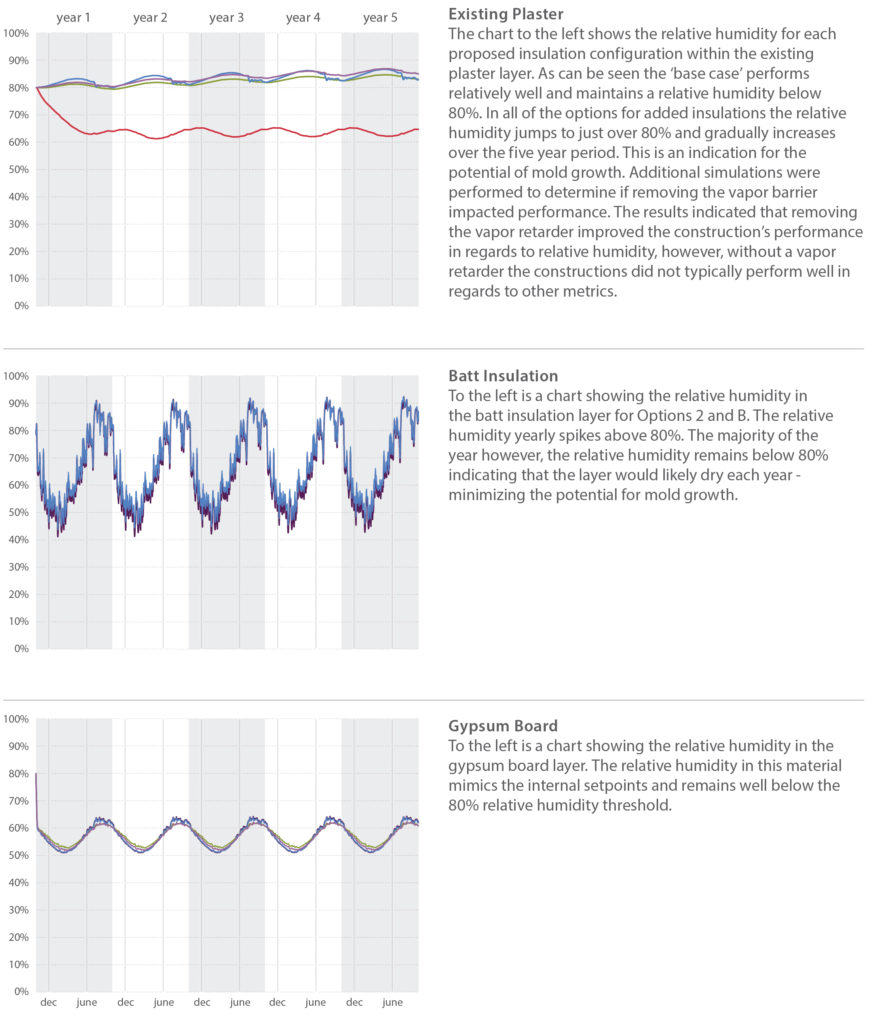
Isopleths WUFI can also predict mold growth by plotting isopleths on the interior surface. The isopleths are plots of the temperature and the relative humidity for every time period calculation. When the temperature and relative humidity both exceed the limiting lines calculated by WUFI there is the potential for mold growth. The simulations indicate that there is very little potential for mold growth. All of the simulations begin above the limiting lines, but over time equalize and remain well below the threshold calculated by WUFI.
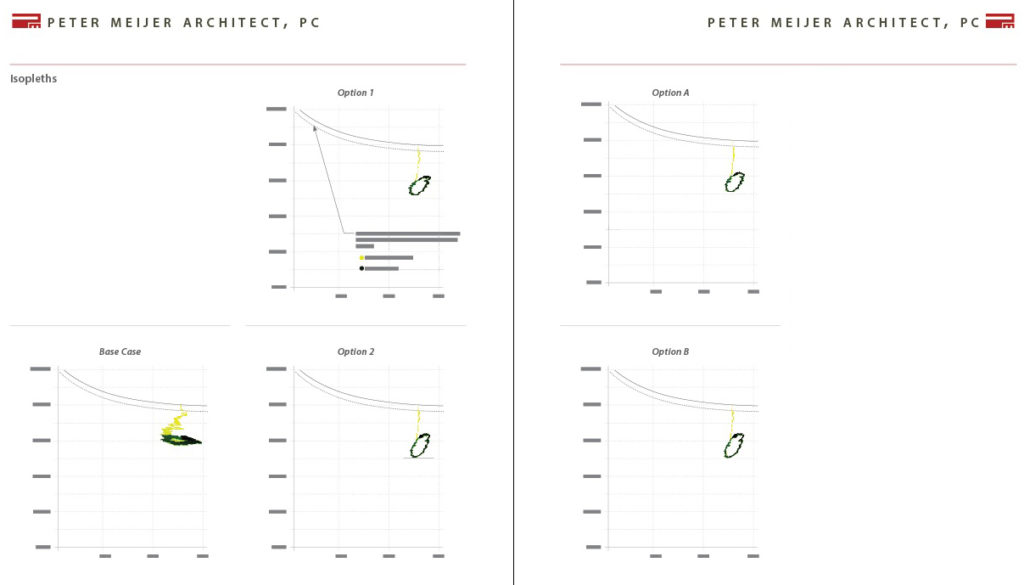
CONCLUSIONS
The results described above indicate that there could be some challenges to designing an appropriate insulation system for Wilmer Davis Hall. Three of the primary concerns noted in the above analysis are: increasing total water content quantities; high quantities of water in the batt insulation layers; and consistently high relative humidity’s in the existing plaster layer.
In general Option 1 and Option A performed better than Option 2 and Option B – primarily because they relied on only foam/rigid insulation. This resulted in no risk of mold growth within the insulation layers and no reduction of the R-Value. Concerns were still identified with both Options in terms of total water content and relative humidity in the plaster layer.
Prior to detailing a new wall for construction additional analysis is recommended. Minor changes in material properties can have significant impacts on wall performance. The above analysis has indicated that there is a potential for mold growth, but has not confirmed its likelihood. Most of the metrics indicated no risk of mold growth – however because some of the metrics showed a potential for mold, additional analysis is recommended. Testing of the existing materials and specific data on proposed products should be used to refine this analysis and determine extent of mold growth risk.
Written by Halla Hoffer,AIA, Assoc. DBIA / Associate, Architect
Overview of Architectural Styles in Oregon: 1840s to 1970s
The City of Gresham applied for and was granted a CLG grant from the State Historic Preservation Office to increase community interest in historic preservation. The City felt that a presentation focused on architectural styles would likely to generate interest among the community. They contacted PMA to provide a power-point presentation geared towards citizens with no planning or architecture background, but also useful for City staff and historians. PMA
presented an overview of Oregon Architectural Styles. We used local Gresham area examples with state-wide examples in the presentation to highlight the residential and commercial styles most likely to be seen in the Gresham area.
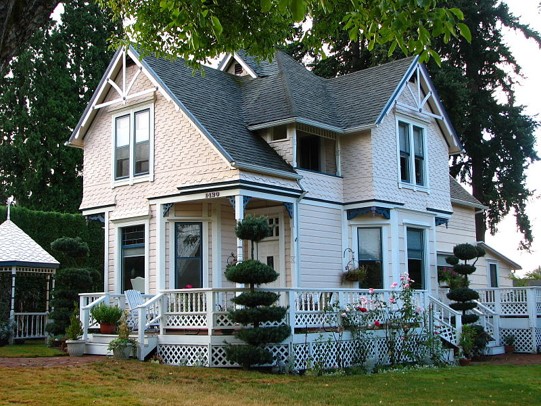
USE, TYPE, STYLE
It is difficult to understand style without an appreciation of the ways style can be overlaid on various types and uses of buildings. The USE of a building is its primary function. For instance, a church (use) might have a hall with steeple (types or forms) and be Neoclassical (style). The use or purpose of a building is strongly linked to its form, but even within a category of use such as residential, one might find various types such as “apartment block,” “bungalow,” or “four-square.”
TYPE just means the basic form, so it is useful for historians to categorize these forms into expected sizes or arrangements of volumes. An apartment block is generally a simple rectangular building with several apartment units and a shared entry. A bungalow is simply a small house, one or 1.5 stories, horizontal in expression. Bungalows are often Craftsman in style, but a handful of other styles are sometimes used with a bungalow type. A four-square is a larger house, typically 2 or 2.5 stories, consisting of a somewhat square footprint with 4 rooms on each floor, and a broad front porch with columns or posts.
The building’s STYLE is determined by the architectural and ornamental details and exterior features applied to the basic structure. Styles change with the times. In fashion and out of fashion, some endure longer. The timeline included is generally reflective of Oregon architectural fashions. However, style also can be affected by technology- for example, the development of steel frame buildings allowed for a new style to emerge: Modernism. Older bearing-wall masonry construction only allowed for small windows set between structural wall areas. A proliferation of new building types, such as the geodesic dome, occurred in the Modern era.
We categorize buildings by type, use, and style when doing a survey of resources in a particular area. The data can be compared quickly and easily to data from other surveys, so we can see the patterns and history of development emerging in any particular area.
STYLISTIC TIMELINE OF ARCHITECTURAL STYLES IN OREGON
From Vernacular Forms and Styles, to Renaissance Revivals, Northwest Regional Style and Post Modern, Oregon has a robust and diverse vocabulary of architecture. The stylistic timeline below is meant as a broad overview, highlighting key attributes per style listed, to help you identify your local Gresham area, greater Metro area, and and PNW regional architectural resources.
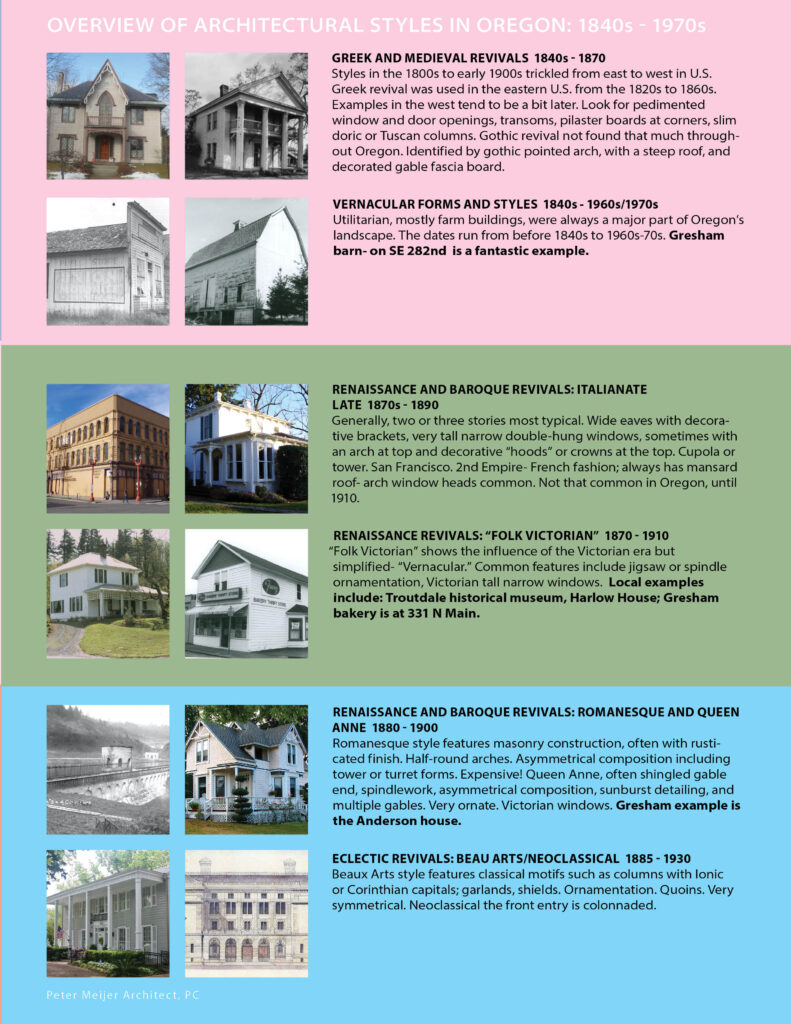
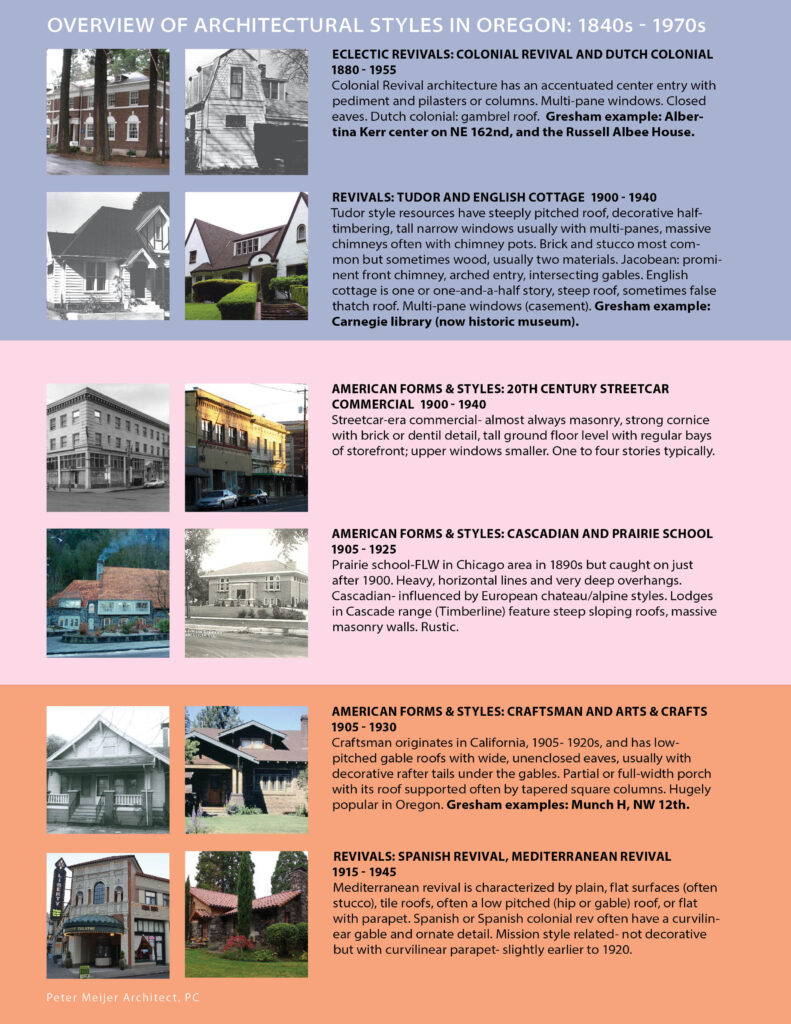
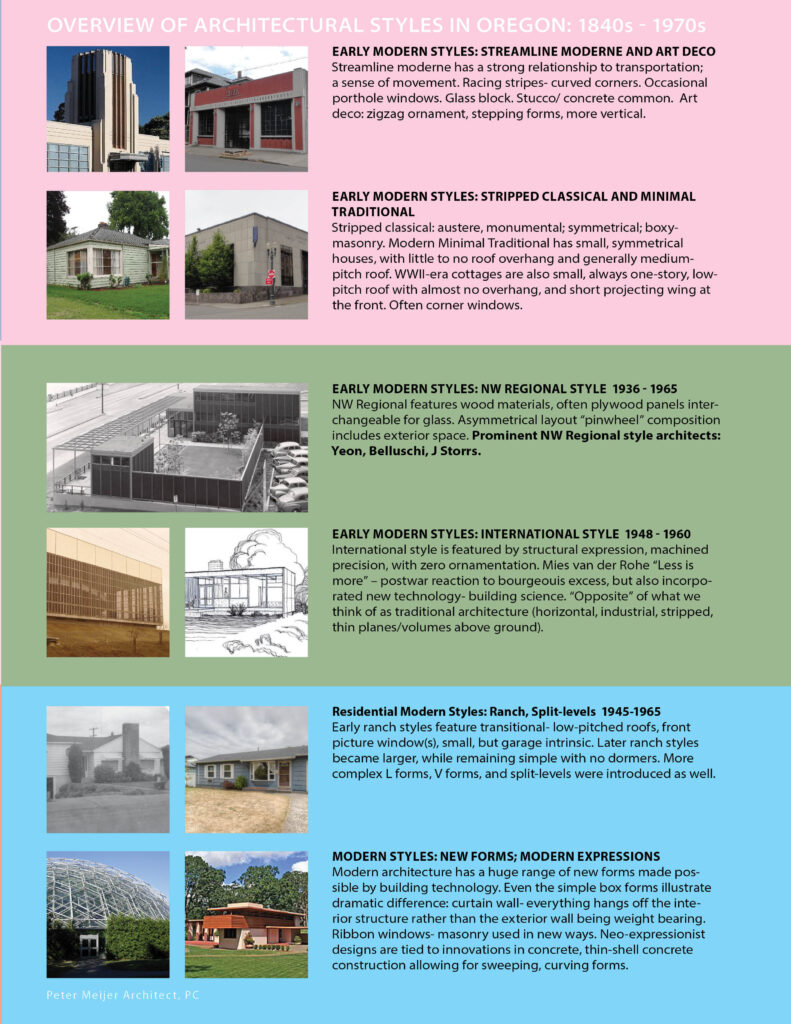
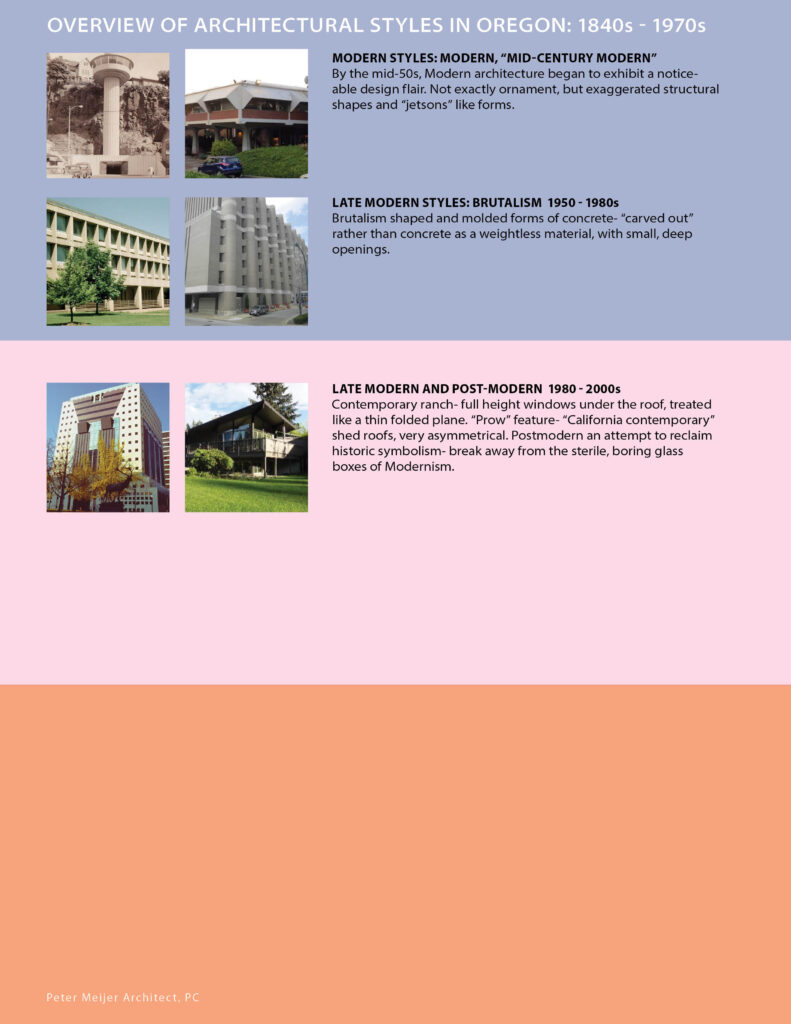
The Form and Function of Lighting Design
When we experience an interior architectural space, lighting plays a large role in setting the mood and functionality of a space. No matter an existing, modern or historic building, light of a space is a critical aspect of great interior design. Lighting elements can be designed to enhance the space and architectural details, set the mood, and compliment furniture, color schemes, and art work. For spaces without an abundance of natural light, lighting design becomes even more critical design consideration. For a recent project, PMA designed lighting schemes for two historic four-story tall interior atriums.
The existing atriums utilize natural light from skylights above; however the original design provided no artificial overhead lighting in the space. During the winter months or at dusk and night, the light quality of space relies on the little ambient light from the skylights or artificial light from the surrounding rooms and halls. The light during these times is inadequate for the necessary function of the space. PMA was tasked with providing a lighting solution that would sensitively address the historic nature of the atriums and provide adequate visibility in the space.
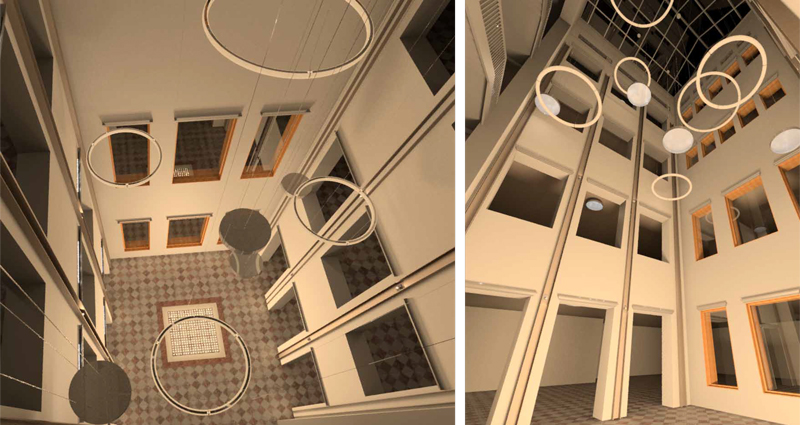
Defining the Project Challenges
The concepts for our lighting schemes were based on the intended function of each identical space. The focus of the design and specified need of the client was to provide lighting for evening social gatherings, networking, and overall entertaining. Lighting needed to be adequate enough for speakers presenting to a crowd and for listeners to be able to read any related literature. Therefore, it was crucial to design lighting schemes that could provide ample lighting for evening events without compromising the historic integrity and ambiance of each space. To provide a solution for our clients’ challenge, we considered the following when approaching our design for the lighting schemes:

Methodology for Design Solutions
The prominent design goal was to increase overall light levels through a refined, modern scheme that would provide juxtaposition to the historic architectural elements and hanging sculpture. As in any historic project, it is important to avoid solutions that are faux historic, competing with, compromising, or confusing the original historic character. The few pragmatic design parameters defined by the client allowed for design freedom to provide several unique, distinct solutions. While creating our designs, PMA experimented with the type of fixtures (down lights, sconce, defused) and placement of these fixtures within the large volume of the atriums. PMA explored these options in a Revit model of the atrium spaces, which enabled evaluation of the design solutions through lifelike renderings that portrayed the quality and levels of light. Illuminance studies of lux levels provided a way to evaluate each design and provide refinement to meet necessary levels defined by the function of the space. Some lighting design options included:
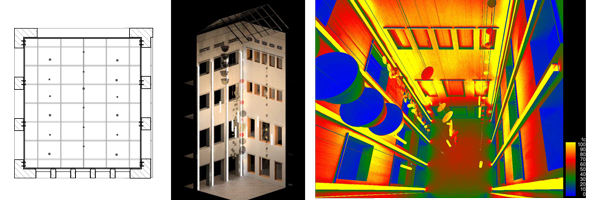
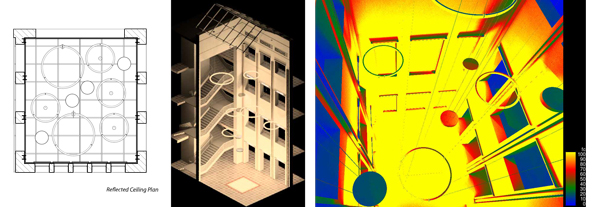
Scheme 1 unified serval lighting design ideas to provide different light level options in the space. Wall sconce lights provide general illumination of the space. Large circular hanging fixtures consist of defused tube lights and large circular defused downlights. Each group of fixture types can be controlled independently and dimmed to provide the ambience desired.
Scheme 2 specifically works with the sculptures in the second atrium space. Vertical ribbon lights provide ambience illuminance of the space while concealing non-historic structural elements. Pendant lights hang interspersed within the sculptural elements. These have a defused light with an option for downlights. Each grouping of fixtures can be illuminated together or separately depending on the quality of light needed.
Scheme 3 was chosen by the client and until announced must remain confidential. Stay tuned for the reveal.
Written by Hali Knight.
2016 Year in Review
As we look back over the past year and reflect on our completed, on-going, and upcoming projects, we’d like to take the opportunity to say we have truly enjoyed collaborating and communicating with you!!
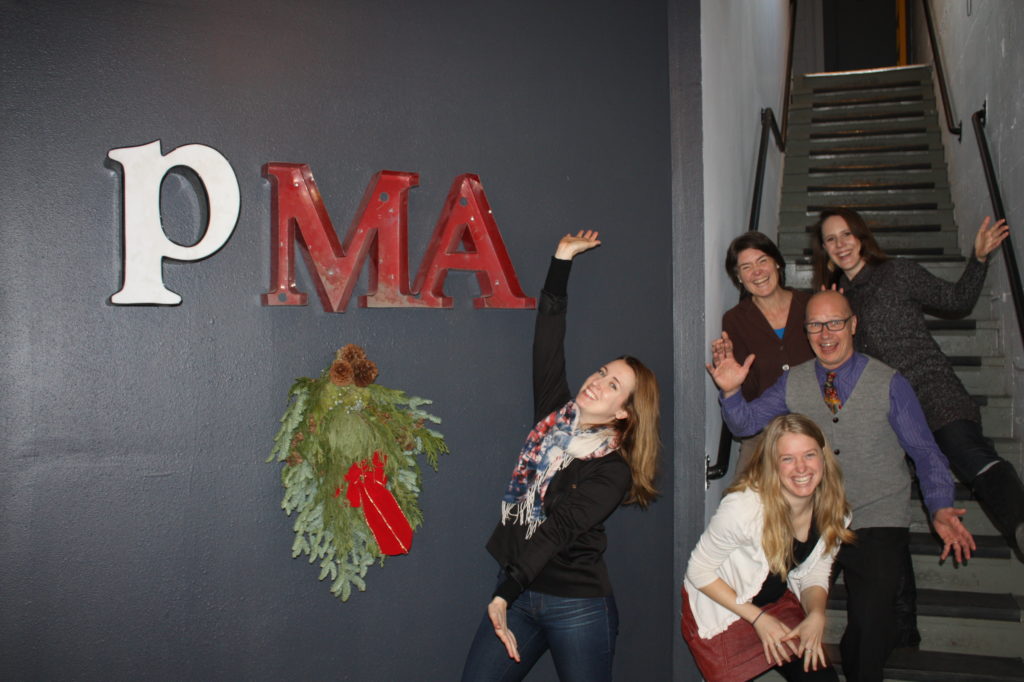
2016 PROJECT HIGHLIGHTS

From top, left to right: Studio Building Exterior + Window Assessment (Portland, OR); Joseph Vance Building Exterior Envelope Repair (Seattle, WA); PPS Grant High School Modernization (Portland, OR); SPS Magnolia School Renovation (Seattle, WA)
PMA HAPPENINGS
 We are excited to announce: Halla Hoffer, Associate, successfully passed her ARE and is a licensed Architect in the state of Oregon.
We are excited to announce: Halla Hoffer, Associate, successfully passed her ARE and is a licensed Architect in the state of Oregon.
Halla is passionate about rehabilitating historic and existing architecture – integrating the latest energy technologies to maintain the structures inherent sustainability.
 We are committed to the reuse and adaptability of existing resources, and in 2016 moved from Silver to Gold certification!
We are committed to the reuse and adaptability of existing resources, and in 2016 moved from Silver to Gold certification!
State and Federal Historic Preservation Incentives Available in Oregon
Historic Preservation Incentives at the State and Federal level are either tax incentives or grants. PMA keeps up to date regarding these programs as incentives are ever-changing and apt to suddenly sunset or be revised. Following is a brief explanation of incentives offered by state or federal government or private agencies as of 2016. PMA has worked with multiple owners and agencies across the Pacific Northwest to take advantage of state and federal tax incentive programs, and we can provide expert experience in the latest interpretations of work that meets the standards for these incentives. A few other redevelopment incentive programs are also mentioned below, if they have been successfully combined with historic preservation incentive programs in Oregon.

FEDERAL AND STATE OF OREGON TAX INCENTIVES
Oregon Special Assessment
Federal Historic Tax Credit Incentives (HTC)
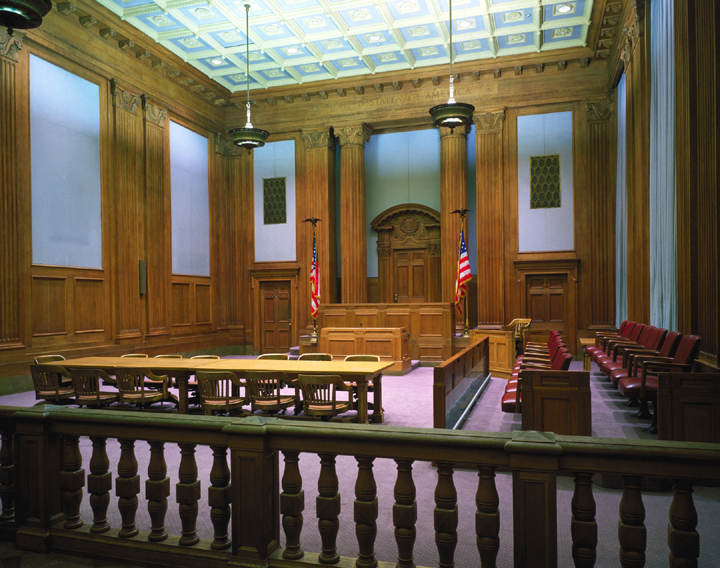
Federal Preservation Easement Tax Deduction
A preservation easement is a legal agreement to protect a historic property from changes, including neglect. The property must be individually listed on the NRHP or a contributing structure within a National Register-listed historic district or local historic district. If a property owner makes a voluntary donation to a trust such as the Historic Preservation League of Oregon (HPLO) of all or a portion of a property, the donation can qualify as a charitable tax donation. Only some of the rights associated with the property are being donated, and the donation permanently limits uses or changes as specified. The owner of the historic property may still use the property, and must maintain it. The owner may sell the property, but the restrictions will remain with the property. The preservation easement may be structured to include only the exterior of a building, or may include air rights, interiors, grounds, or other features.
OTHER INCENTIVES OR PROGRAMS
Private and Public Grants
Grants for historic preservation work vary widely as to eligibility rules, requirements, and amounts. While private-sector grant-making organizations are more apt to change grant programs or requirements year-to-year, they also are more likely to provide larger sums of money. Historic preservation grants are sometimes only available for preservation planning, survey, or designation work as opposed to “brick and mortar” projects.
The State Historic Preservation Office (SHPO) administers Federal grants directly to local government entities through the Certified Local Government (CLG) program. The SHPO also administers State grants through the Oregon Heritage Grants, Oregon Museums Grants, Preserving Oregon Grants, Diamonds in the Rough Grants, and Oregon Historic Cemeteries Grants. These are all competitive and offer relatively modest amounts of funding.
New Market Tax Credit
In December 2015, Congress approved an extension of the New Market Tax Credit (NMTC) program through 2019. There is an immediate opportunity for investors, low-income communities, and businesses to use this successful program in order to revitalize economically distressed areas and create jobs. The State also runs the Oregon New Market Tax Credit program, which is modeled on the same requirements as the Federal program.
The Blanchet House of Hospitality, a new (2012) building in a historic district in downtown Portland, used New Markets Tax Credits. NMTC and HTC have also been used together, such as in the Mercy Corps restoration/ expansion in the Skidmore Old Town historic district.
The NMTC is not available for loans or investments in projects involving residential rental housing alone, but may be used for mixed-use and some other housing projects. Investments must be made to designated Community Development Entities (CDEs), which in turn provide investments in low-income communities. The investment is claimed over a 7-year credit allowance period.
Low-Income Housing Tax Credits
The federal government allots a certain amount per state per year to be awarded to developers willing to provide low income housing. Residential rental properties only may qualify for the Low-Income Housing Tax Credits (LIHTC) program. A certain percentage of the units must be restricted to occupants making 50% or less (or 60% or less) of local median income, and the affordability restrictions must be maintained for a minimum of 30 years. LIHTC has been successfully combined with HTC in downtown Portland projects such as the Admiral Apartments, the Martha Washington, and the Bronaugh Apartments.
Written by Kristen Minor, Associate/Preservation Planner
Local Historic Preservation Incentives Available in Portland, Oregon
With a firm comprised of architects and planners, we understand and assist owners and developers navigate local historic preservation incentives made available by the City of Portland. The following is a comprehensive overview of incentives offered by the City, as of 2016, in the form of various use allowances, development rules “waivers,” and opportunities to transfer allowed but unused floor area to other property owners, creating an opportunity for a monetary benefit. We grouped the available historic preservation incentives available by the following: City of Portland Incentives, City of Portland/State of Oregon Building Code Allowances, and Portland Development Commission Programs.
The City of Portland’s Central City 2035 Plan (as well as other related City code projects) are currently under review. The Proposed Draft was published in June 2016 and is being reviewed by many City and non-City agencies, bureaus, and organizations. Proposed changes directly affect portions of the Portland Zoning Code, but the existing Zoning Code will remain in effect until adoption of the final Central City 2035 Plan, probably in late 2018. Increased transfer options are the major change proposed.
“Landmark” as defined by the City is a property individually listed on the National Register, or evaluated by the City of Portland as a local historic resource. Many incentives are also available to resources designated contributing to a National Register-listed Historic District or locally designated Conservation District.
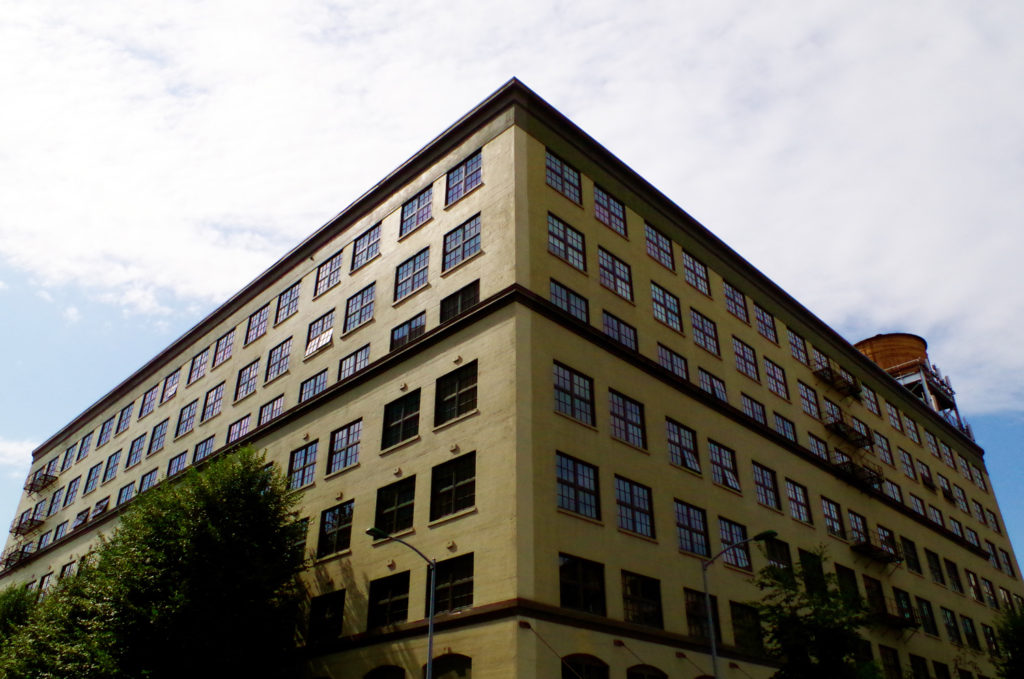
Marshall Wells Lofts building preservation plan.
CITY OF PORTLAND INCENTIVES
Additional density in Single-Dwelling zones. Landmarks in Single-Dwelling zones may be used as multi-dwelling structures, up to a maximum of one dwelling unit for each 1,000 square feet of site area. No additional off-street parking is required, but the existing number of off-street parking spaces must be retained. The landmark may be expanded and the new floor area used for additional dwelling units only if the expansion is approved through historic design review.
Additional density in Multi-Dwelling zones. Landmarks and contributing structures in historic districts located in multi-dwelling zones may be used as multi-dwelling structures, with no maximum density. No additional off-street parking is required, but the existing number of off-street parking spaces must be retained. The building may be expanded and the new floor area used for additional dwelling units only if the expansion is approved through historic design review.
Nonresidential uses in the RX zone. In the RX zone, except on certain sites which directly front on the Park Blocks, up to 100 percent of the floor area of a landmark or contributing structure may be approved for Retail Sales and Service, Office, Major Event Entertainment, or Manufacturing and Production uses through Historic Preservation Incentive Review.
Nonresidential uses in the RH, R1 and R2 zones. In the RH, R1 and R2 zones, up to 100 percent of the floor area of a landmark or contributing structure may be approved for Retail Sales and Service, Office, or Manufacturing and Production uses as follows:
Daycare is an allowed use in all residential zones in historic landmark or contributing structures. In non-historic structures, daycare uses in residential zones other than RX require a conditional use review.
Conditional uses in Residential, Commercial, and Employment zones. In these zones, applications for conditional uses at landmarks or contributing structures are processed through a Type II procedure, rather than the longer Type III procedure requiring a public hearing.
Exemption from minimum density. Minimum housing density regulations do not apply in landmarks or contributing structures.
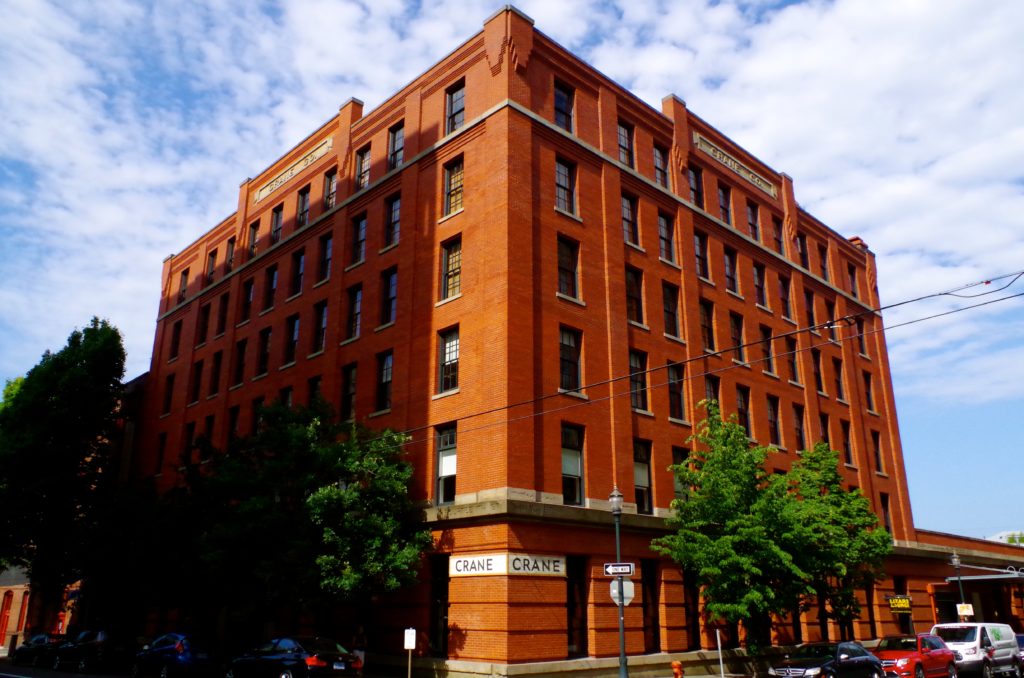
Crane building historic consulting for storefront updates.
Commercial allowances in Central City Industrial zones. National Register-listed properties or those contributing to a National Register-listed historic district have potential to include office and retail uses.
Commercial allowances in employment and industrial zones. Office and retail uses are allowed in landmarks in areas where those uses are otherwise restricted.
Increased maximum parking ratios in Central City. National Register-listed properties or those contributing to a National Register-listed historic district within the Central City Core parking area are allowed to increase parking ratios.
Commercial allowances in Guild’s Lake Industrial Sanctuary District. Increases allowances for office and retail uses in landmarks in an area where non-industrial uses are otherwise restricted.
The transfer of density and floor area ratio (FAR) from a landmark to another location is allowed in Multi-Dwelling, Commercial, and Employment zones. Historic properties with unused development “potential” therefore may find a market for the FAR.
Proposed Development transfer opportunities (potentially adopted in 2018):
Landmarks and contributing resources in historic districts will be able to transfer FAR City-wide, as long as the “sending” resource meets seismic reinforcement standards. Seismic work may be allowable in phases over a period of years. FAR to be transferred is not only the base amount unused by the existing historic structure, but also an additional 3:1.
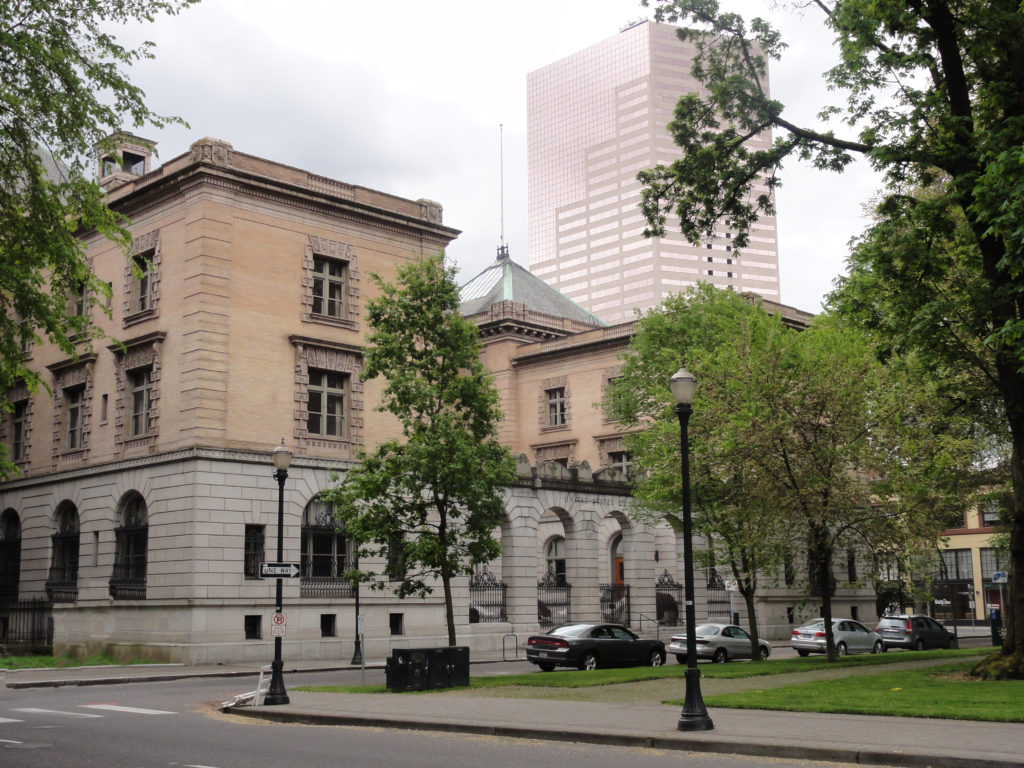
U.S. Custom House renovation and historic tax credits.
PORTLAND DEVELOPMENT COMMISSION PROGRAMS
The Portland Development Commission (PDC) has operated several programs to benefit owners of existing buildings (not necessarily historic buildings). These programs have been suspended and will be replaced by the Prosperity Investment Program (PIP). Information about the PIP is not yet available, but the program may still provide benefits to owners, similar to the suspended Storefront Improvement Program.
For further information on how PMA helps owners consider reuse options, navigate the regulations, and take advantage of available benefits – please visit our website to review our multidisciplinary projects and comprehensive architecture, building envelope science, and planning services.
Written by Kristen Minor, Associate, Preservation Planner
